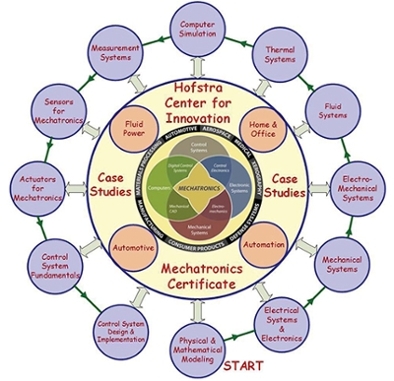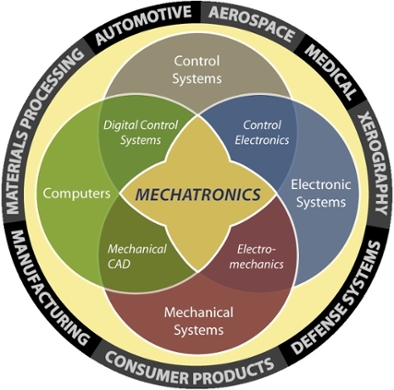- Module #1 Overview: Physical & Mathematical Modeling
Physical model simplifying assumptions and hierarchy of physical system models: design model, control-oriented model, and truth model; physical models of elementary mechanical, electrical, electromechanical, thermal and fluid systems; through and across variables, effort and flow variables; energy storage and energy dissipation; analogies among elementary physical models; application of the laws of nature to elementary physical systems; classification of system inputs; linearization of nonlinear physical effects; loading effects; sensitivity analysis; 1st- and 2nd-order linear, time-invariant, dynamic system continuous and discrete mathematical models; block diagram, transfer function, and state-variable representations; time response and frequency response of 1st- and 2ndorder dynamic systems; analogies among elementary mathematical models.
- Module #2 Overview: Electrical Systems and Electronics
Voltage, current, power, resistance and impedance; resistor (R) and potentiometer: physical and mathematical model, impulse and step response, frequency response, impedance, types and important uses; Kirchhoff’s circuit laws: KVL and KCL; current and voltage sources and meters: ideal and real; resistive circuit analysis; circuit loading; capacitance (C) and inductance (L): physical and mathematical models, impulse and step response, frequency response, impedance, types and important uses; LR and LRC circuit system investigations; op-amps: ideal and real, configurations, and uses; comparator and Schmitt trigger; diodes: light-emitting diode (LED) and photodiode; transistors: bipolar junction transistor (BJT) and metal oxide semiconductor field effect transistor (MOSFET); H-bridge analysis; digital logic circuits; pulse-width modulation. Laboratory measurements and implementation: breadboards, multimeter, oscilloscope, function generator, power supply, microcontroller, dynamic signal analyzer (DSA). Common industrial electrical and electronic circuits for power and control. Extensive use of MatLab, Simulink, and SimElectronics.
- Module #3 Overview: Mechanical Systems
Three-dimensional kinematics and kinetics. Fundamental concepts: particle, rigid body, force, torque, mass, mass moment of inertia, inertia matrix, degrees of freedom, generalized coordinates, constraint, reference frames, free-body diagram, dynamic stability, Coriolis acceleration; Basic Elements: ideal and real, inertia, compliance, and energy dissipation. Force and motion inputs. Motion transformers: linkages, cams, belts, gear trains (fixed-axis and planetary). Mechanical impedance. Laws of Nature: force-mass-acceleration, work-energy, impulse-momentum, Newton-Euler, D’Alembert, Lagrange. Time and frequency dynamic system response. Applications: belt-drive fundamentals; slider-crank fundamentals; web-transport systems; dynamic balancing; shaft whirling. Parasitic and Nonlinear Effects: nonlinear springs, nonlinear friction (Coulomb, air, structural, eddy-current), gear backlash. Compliantly-coupled systems: advantages, disadvantages, resonance, anti-resonance, nonlinear resonance (e.g., springpendulum), dynamic vibration absorber, vibration isolation, couplings, compliant mechanisms. Electrical-mechanical analogies. Industrial Applications: automation, automotive, aerospace, home appliances, fluid-power machines, and robotics. Extensive use of MatLab, Simulink, and SimMechanics.
- Module #4 Overview: Electro-Mechanical Systems
Magnetic and magnetically-coupled circuits: magnetic field; magnetic circuits; Faraday’s Law and Lenz’s Law; stationary magnetically-coupled circuits; magnetic systems with mechanical motion - elementary electromagnet, elementary reluctance machine, windings in relative motion; properties of magnetic materials. Principles of electromechanical energy conversion: energy balance relationships; energy in coupling field; electromagnetic and electrostatic forces; magnetic systems with mechanical motion - elementary electromagnet, elementary reluctance machine, windings in relative motion. Forces and torques in systems with permanent magnets. Applications: linear DC machine, solenoid, magnetic levitation system, and vibration exciter. Laboratory demonstrations. Industrial applications. Extensive use of MatLab, Simulink, and SimPowerSystems.
- Module #5 Overview: Fluid Systems
Rheological classification of materials. Fluid properties: density, viscosity, bulk modulus. Basic concepts: continuum, velocity field, stress field. Basic equations: Conservation of Mass, Newton’s 2nd Law, Conservation of Energy, Moment of Momentum, 2nd Law of Thermodynamics. System and control volume, integral and differential formulations. Lumped-parameter approach: fluid resistance, compliance, and inertance. Fluid impedance. Fluid sources: pressure and flow rate. Hydraulic cylinders, motors, control (pressure, flow, direction) valves, proportional and servo-valves, pumps, and transmission lines all integrated into a fluid power system. Pump-controlled systems. Valve-controlled systems. Industrial applications. Extensive use of MatLab, Simulink, and SimHydraulics.
- Module #6 Overview: Thermal Systems
The integration of heat transfer, thermodynamics, and fluid mechanics to study both the steady state and transient behavior of real-world thermal systems. Thermal capacitance and resistance. Heat transfer modes: conduction, convection and radiation – physical mechanisms and mathematical models. Thermal sources: temperature and heat flow. Electrical-thermal analogy. Thermal system investigations motivated by industrial applications. Extensive use of MatLab and Simulink.
- Module #7 Overview: Computer Simulations
MatLab and Simulink are used for problem solving programming and dynamic system simulation. Use of transfer functions, block diagrams, and state-space dynamic system model representations. Use of MatLab Simscape for physical system modeling and analysis including SimMechanics, SimHydraulics, SimElectronics, SimPowerSystems, and SimDriveline. Use of MatLab Stateflow to simulate decision logic using state machines and flow charts. Optimization in MatLab. Automatic real-time code generation in Simulink. Symbolic mathematics in MatLab.
- Module #8 Overview: Measurement Systems
Types of applications of measurement instrumentation; generalized configurations and functional descriptions of measuring instruments; generalized performance characteristics of instruments; uncertainty analysis; signal characteristics; Fourier analysis; measurement statistics; signal conditioning; digitization, sampling, aliasing, and quantization; analog and digital sensor types: strain measurement; displacement, velocity, and acceleration measurement; force, torque, and power measurement; pressure and flow measurement; temperature measurement.
- Module #9 Overview: Sensors for Mechatronics
Selection, modeling, analysis, experimental verification, evaluation, and implementation of a variety of sensors for mechatronic applications. Analog and digital sensors studied include: optical encoders, Hall-effect sensors, potentiometers, accelerometers, gyroscopes, variable-inductance transducers, permanent-magnet transducers, eddy-current transducers, variable-capacitance transducers, and piezoelectric transducers. Sensor fusion and creation of virtual sensors.
- Module #10 Overview: Actuators for Mechatronics
Electromechanical Actuators: brushed DC motor, brushless dc motor, and step motor. Electrohydraulic Actuators: hydraulic cylinder and hydraulic motor. Model-based actuator selection process. Physical and mathematical modeling of each actuator. Dynamic analysis of each actuator using MatLab / Simulink. Trajectory planning using electronic cams. Implementation power and control electronics for each actuator. Integration issues of the actuator into the multidisciplinary engineering system. Extensive use of MatLab, Simulink, and Simscape (SimHydraulics, SimElectronics, and SimPowerSystems).
- Module #11 Overview: Control System Fundamentals
Control system types: open-loop control (basic & feedforward) and closed-loop control; major control concepts; control system design procedure; generalized feedback control block diagram; block diagrams and loading effects; feedback control transfer functions; sensitivity of control systems to parameter variation; negative feedback and op-amps; instability in feedback control systems; performance and stability; time delay and saturation; proportional, integral, and derivative control modes; disturbance response; tuning a control system; industrial controllers; command feedforward response. Industry examples and case studies. Extensive use of MatLab, Simulink, SISO (single-input, single-output) MatLab tool, and the MatLab Control Design Toolbox.
- Module #12 Overview: Control System Design & Digital Implementation
Control system analysis and design using three complementary methods: root-locus, frequency-response, and state-space. PID control modes and approximate control modes (lead, lag, and leadlag). Digital implementation of control. MIMO (multiple-input, multiple-output) control approaches. Industry examples and case studies. Extensive use of MatLab, Simulink, SISO (single-input, single-output) tool, and Control Design Toolbox.






